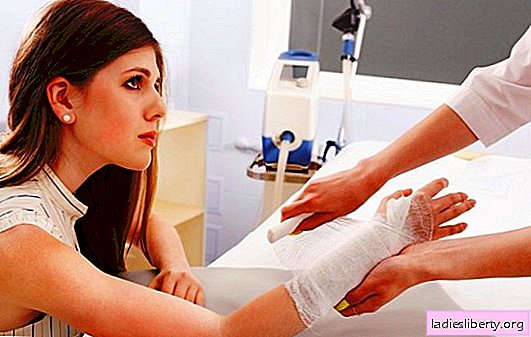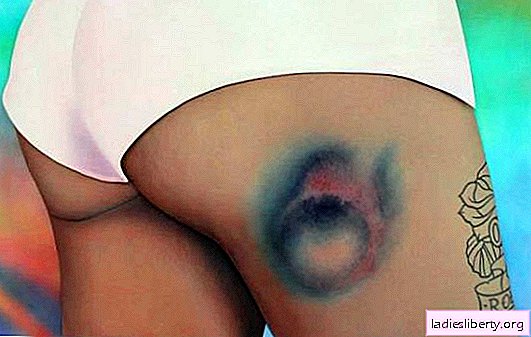
Pain in the area of the jaw joint may indicate the development of inflammation and dangerous diseases. Consider in more detail the symptoms of inflammation of the jaw joint and the most affective methods of treatment.
Inflammation of the jaw joint: the main causes of the disease
Most often, the jaw joint becomes inflamed for the following reasons:
1. Mechanical injury. This can be a fall or a blunt blow to the jaw, in which soft and bone tissues are severely injured. Also, with a jaw injury, you may experience:
• hematoma formation;
• rupture of the internal capsule of the joint;
• crack or fracture.
Due to trauma in the joint cavity, inflammation occurs. This leads to accumulation of fluid and a sharp deterioration in the mobility of the jaw.
2. Infection also threatens the development of the inflammatory process. The infection itself can penetrate the joint in the following ways:
• direct (with a fracture, a bullet wound, knife cuts, etc.);
• contact (in diseases such as an abscess, phlegmon, boil, purulent mumps and otitis media);
• hematogenous (develops in acute fungal, bacterial or viral diseases).
Typically, hematogenous infection occurs in such diseases:
• measles;
• gonorrhea;
• sepsis;
• syphilis;
• diphtheria;
• tuberculosis;
• tonsillitis.
3. Rheumatoid arthritis quite often cause inflammation of the jaw joint. With this disease, a person is greatly affected by the soft tissue of the joints. Jaw inflammation is observed in almost 20% of patients.
To date, there is no accurate information about the causes of rheumatoid arthritis. Scientists identify the provoking factors of the disease. They are a hereditary predisposition and various viral infections (hepatitis, herpes, etc.).
4. Lupus erythematosus - This is a disease in which a person’s immune system is impaired and joints are damaged. It is also important to know that the joints themselves are not deformed, so after treatment the discomfort can disappear altogether.
5. Reactive arthritis accompanied by severe inflammation of the joints (including the jaw joint). It occurs after a previous infection in the genitourinary system or intestines. The very deterioration of the condition of the joints in this case occurs due to the defeat of the patient's tissues by some microorganisms.
6. Gout is accompanied by metabolic disorders, which is why uric acid begins to be deposited in the patient’s body tissues.
Usually, this disease develops due to malnutrition, with a lack of nutrients or a sedentary lifestyle.
Due to the large accumulation of this substance to the blood, salt begins to collect in the joints, which leads to the development of inflammation, acute pain and burning.
Inflammation of the jaw joint: symptoms and manifestations
Acute inflammation of the jaw joint is accompanied by the following symptoms:
1. The pain. This is the most common sign of inflammation. The nature of the pain can be different: sharp, aching, stitching and cutting. Intensity - strong and often recurring (especially after chewing food).
Also, sometimes pain can give off to other parts of the face (upper jaw, ears, etc.). This is due to the fact that different parts of the soft tissues on the face are innervated by the same nerve that passes through the jaw joint.
2. Redness and severe swelling are most characteristic of acute arthritis (purulent form), in which pathogenic microbes collect in the joint.
3. An increase in body temperature is primarily associated with vasodilation and the influx of warm blood to the area of the inflammatory process. This provokes the development of such a symptom.
4. The feeling of bursting and squeezing in the joint is observed due to swelling of the tissues.
5. Hearing impairment may occur due to the spread of inflammation. It is also important to know that with infectious inflammation, the disease can spread to the inner ear, causing complete deafness.
6. Fatigue.
7. Fever.
8. Body aches.
9. Weakness.
10. Loss of appetite.
11. Apathy.
12. Pain while eating.
13. Frequent headaches.
14. A sharp increase in blood pressure and exacerbation of hypertension.
Symptoms of chronic inflammation in the jaw joint are:
1. Aching pain. In this case, its intensity will not be so pronounced, however, at the same time, it will deliver to a person no less unpleasant sensations than in an acute form. Also, pain can be paroxysmal and occur at any time.
2. Violation of joint mobility. This will be especially apparent in the morning.
3. The appearance of a crunch in a sore joint, which may be accompanied by pain.
4. A slight increase in temperature.
5. Chronic weakness.
6. A slight decrease in hearing (may be on one ear).
Inflammation of the jaw joint: diagnosis and treatment
Due to the fact that a variety of diseases can become the cause of inflammation in the jaw joint, it is important to identify the source of the disease before starting treatment. To do this, undergo the following diagnostic procedures:
1. General blood test.
2. General urine analysis.
3. Identification of uric acid levels.
4. Analysis of the amount of protein.
5. MRI.
6. X-ray of the jaw joint.
7. CT.
It is also advisable to visit such doctors:
1. Traumatologist.
2. Neurologist.
3. Therapist.
4. Rheumatologist.
5. Dentist.
6. Otorhinolaryngologist.
Inflammation of the jaw joint: treatment methods
The traditional treatment of inflammation of the jaw joint includes the following techniques:
• immobilization;
• drug treatment;
• physiotherapeutic treatment.
1. Immobilization. It is indicated for dislocations, stretch marks, bruises and joint injuries that led to the development of inflammation. The main task of immobilization is the immobilization of the affected joint. For this, a soft chin bandage, a sling-like or parietal-chin dressing can be applied to the patient's face.
Depending on the severity of the patient's condition, he should wear such a bandage from several hours to several weeks.
2. Drug treatment. It is aimed at relieving pain, swelling and improving blood circulation. Most often, the following groups of drugs are prescribed to the patient:
• anti-inflammatory drugs (Nimesil);
• non-narcotic analgesics (Paracetamol);
• for severe pain, narcotic pain medications may be prescribed (Tramadol, Morphine);
• cytostatics against inflammation (Cyclophosphamide, Azathioprine).
Important to seem that these drugs can be taken either orally in the form of tablets, or injected.
3. Physiotherapy usually carried out after drug treatment as a restorative procedure. The duration of such treatment is determined by the attending physician depending on the severity of the disease and the condition of the patient.
Traditional physiotherapeutic treatment includes the following complex of procedures:
1. UHF therapy. It is aimed at the effect of an electric field on the affected tissue. In this case, the energy that is radiated by this field will be absorbed by diseased cells, which will lead to improved blood circulation and normalization of endocrine systems.
UHF therapy also has the following therapeutic effects:
• relieves pain;
• nourishes tissues;
• relieves inflammation;
• improves metabolism in the patient’s tissues.
To achieve the maximum therapeutic effect, this procedure must be performed twice a day with a duration of fifteen minutes. The general course of treatment should not be longer than two weeks. You can repeat it after two months.
2. Electrophoresis - This is one of the varieties of physiotherapeutic procedures, which involves electric shock treatment and various medications. When the current enters the affected area, it has the following therapeutic effect:
• anesthetizes;
• relieves inflammation in the joint;
• relaxes;
• improves blood circulation.
Most often, in diseases of the joints, doctors use electrophoresis with novocaine. It effectively helps relieve pain.
In this case, a solution with this drug is applied to electrophoresis, after which it is applied to the patient's body. After applying electric current, the medicine will affect the affected area.
The duration of this procedure is 20 minutes. The course of treatment should include at least 14 sessions.











